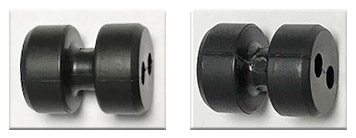To Post-Bake or Not To Post-Bake: The Inside Scoop on Post-Baking Phenolics
With decades of thermoset molding experience including injection molding for phenolic resins, or phenolic molding compounds, a common question asked by our customers is if their application should be post-baked. The answer: “It depends”. While post-baking molded phenolics may provide increased property performance, it is not needed or recommended for all phenolic molding applications.
Whereas thermoset materials such as Bulk Molding Compounds (BMCs) are cured during the molding process, phenolic resins are not fully cured in the mold. Depending on the application requirements, thermoset molders may post-bake phenolic parts during a secondary operation in an oven for added cure, resulting in stronger property performance of the part.
What Materials May Be Post-Baked?
Phenolic resins, or phenolic molding compounds, are thermoset materials that may be post-baked in a secondary operation after the molding process is complete. While other thermosets such as Bulk Molding Compounds (BMCs) or Epoxies are post-baked, the physical property changes are not nearly as impacted as post-baking molded phenolics.
Why Post-Bake Molded Phenolics?
In thermoset molding, thermoset materials are cured during the molding process. Phenolics on the other hand, are only partially, or mostly, cured during the molding operation and never fully reach 100% cure (1). In order for the phenolic molded part to near 100% cure, molders can post-bake the parts in an oven to reach final curing state. The additional cure may provide added heat deflection temperatures for applications exposed to very high heat, or it may provide higher dimensional stability, allowing a part to remain physically and chemically stable even in challenging applications or environments (2).
Aside from stronger property characteristics, post-baking also allows phenolic parts to “outgas” or “degas”, removing excess ammonia not released from the parts during molding operation. Excess ammonia may cause issues with adhesives, orings, and also can create a discomforting smell to assemblers or operators installing the phenolic components.

Post-Baked Part Non Post-Baked Part
(1) ‘Studies of the Post Bake Process of Phenolic Resins’,
by Theodore N. Morrison and Phillip A. Waitkus,
SPI Molding Division Technical Conference, 21st Century Phenolics, June, 1987.
(2) ‘Practical Guidelines for the Efficient Postbaking of Molded Phenolics’
By Theodore N. Morrison,
Thermoset Topical Conference (RETEC), March 2004.
https://www.plenco.com/tips/postbakedetail.pdf



Comments are closed